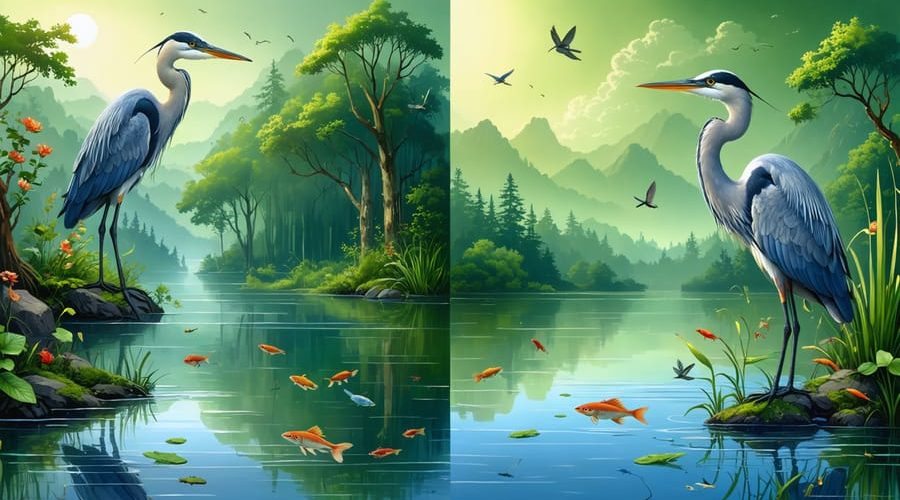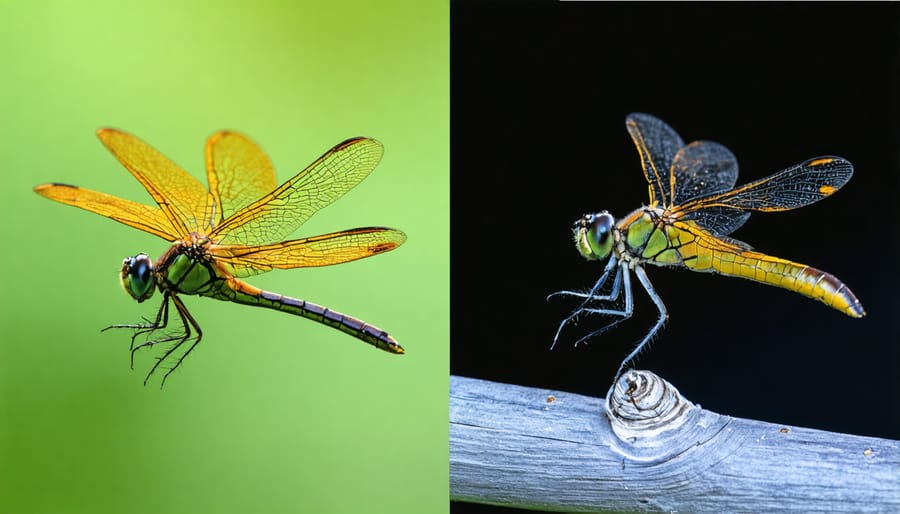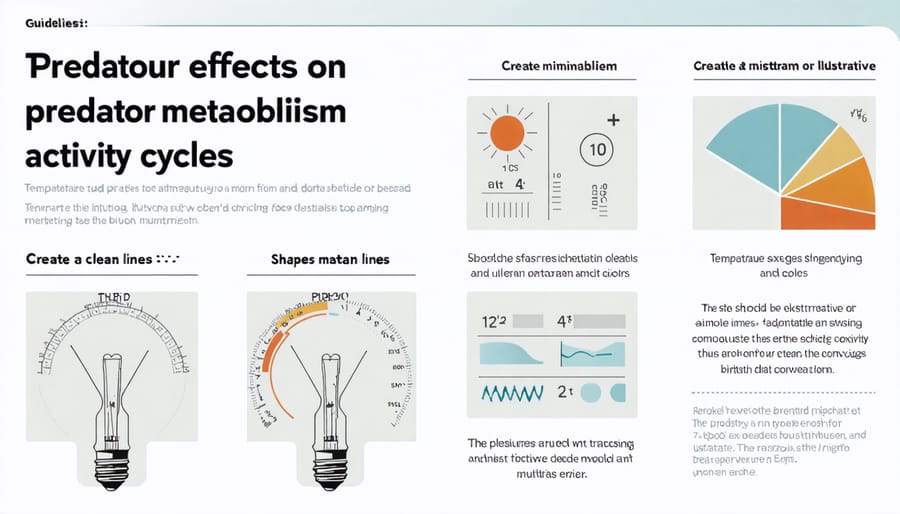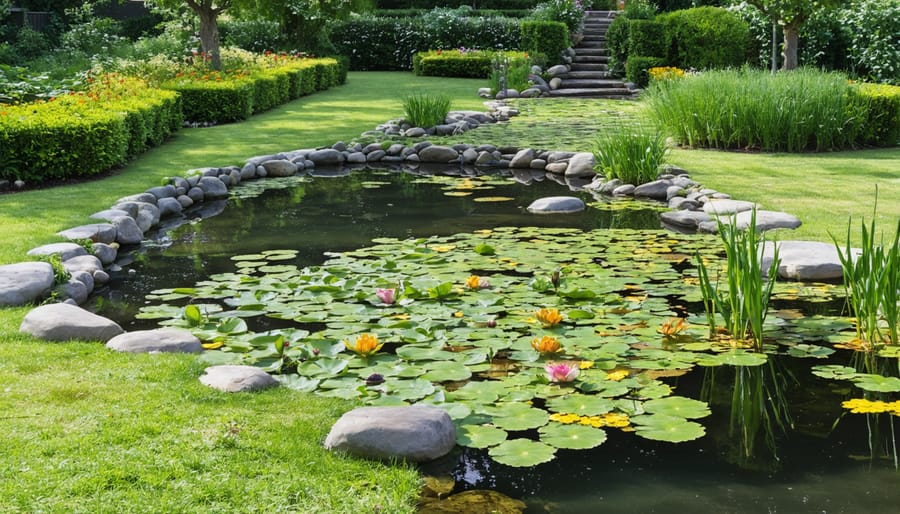
Climate Change is Reshaping Pond Predator Dynamics (Here’s What You Need to Know)
In every backyard pond, a delicate dance unfolds between predators and their prey, shaping the very foundation of aquatic life. Understanding these predator-prey relationships has become increasingly crucial as climate change alters traditional behavioral patterns. From the stealthy movements of herons stalking fish to the lightning-quick strikes of dragonfly nymphs hunting mosquito larvae, predators serve as nature’s essential regulators, maintaining the delicate balance of your pond ecosystem.
As pond owners, we’re witnessing firsthand how warming waters and shifting seasons affect predator behavior in our aquatic gardens. These changes can dramatically impact everything from fish populations to insect control, making it more important than ever to understand and adapt to these natural dynamics. Whether you’re managing a small decorative pond or a larger water feature, recognizing the role of predators isn’t just about protecting your prized koi – it’s about fostering a thriving, self-sustaining ecosystem that can withstand environmental challenges while providing endless enjoyment and natural beauty.
Understanding Pond Predators in a Changing Climate
Common Pond Predators
Garden ponds are vibrant ecosystems that attract various common pond predators, each playing a crucial role in the natural balance. Herons are perhaps the most notorious visitors, swooping down to catch fish with their long beaks. These elegant birds can quickly reduce your fish population if left unchecked.
Water snakes are another frequent visitor, gliding silently through the water in search of small fish and amphibians. While they might seem scary, they’re generally harmless to humans and help control pest populations. Raccoons are opportunistic hunters that will wade in shallow areas, using their dexterous paws to catch fish and frogs.
For smaller prey, dragonfly nymphs and diving beetles are fearsome underwater predators. These insects might be tiny, but they’re incredibly efficient hunters of fish fry and tadpoles. Cats, both domestic and feral, may also visit your pond, particularly during dry spells when they’re drawn to the water.
Understanding these predators helps pond owners create better protection for their aquatic pets while maintaining a healthy ecosystem balance.
Climate-Driven Behavioral Changes
Climate change is having a noticeable impact on predator behavior in pond ecosystems. As temperatures rise, many predatory species are adjusting their feeding patterns and daily routines to cope with the warmer conditions. Fish like bass and pike are becoming more active during early morning and evening hours when temperatures are cooler, rather than during the heat of the day.
These changes can affect your pond’s entire ecosystem. Warmer waters hold less oxygen, which makes predators work harder to catch their prey. You might notice your larger fish spending more time near deeper, cooler areas of your pond or congregating around water features that add oxygen.
Some predators are also expanding their hunting seasons. Species that typically become less active during winter months are now staying active longer into the season. This extended activity period can put extra pressure on prey populations in your pond.
To help your pond adapt to these changes, consider adding more shaded areas, increasing water depth in some sections, and installing additional aeration systems. These improvements can help maintain comfortable zones for both predators and prey, keeping your pond’s ecosystem balanced despite changing climate conditions.

Temperature’s Impact on Predator-Prey Balance
Seasonal Shifts and Extended Activity Periods
Climate change and longer warm seasons are significantly impacting predator behavior in pond ecosystems, altering traditional activity patterns and affecting natural pond balance. Where predators once had distinct active and dormant periods, many species now remain active for extended durations throughout the year.
In pond environments, this means predatory fish and insects are feeding for longer periods, potentially putting more pressure on prey populations. For example, dragonfly nymphs and predatory beetles that typically reduce their hunting during cooler months now maintain higher activity levels well into what were traditionally their quiet seasons.
These shifts can create both challenges and opportunities for pond owners. While extended predator activity can help control unwanted insect populations, it may also mean more frequent feeding is necessary for predatory fish. Water temperature changes associated with longer warm seasons can also affect oxygen levels and metabolism rates, influencing how predators hunt and how frequently they need to feed.
For pond keepers, adapting to these changes means paying closer attention to feeding schedules and population dynamics throughout the year. Regular monitoring of water conditions and prey populations becomes even more crucial as traditional seasonal patterns become less predictable.
Water Temperature and Predator Metabolism
Water temperature plays a crucial role in how predators behave and feed in pond ecosystems. As water warms up, the metabolic rate of predatory fish and other aquatic hunters increases significantly. This means they need more food to maintain their energy levels, leading to more active hunting behavior.
In warmer waters, predators like bass, pike, and larger fish spend more energy swimming and digesting food. Their increased metabolism can lead them to consume up to 30% more prey compared to cooler conditions. This heightened feeding activity can quickly impact the population balance of smaller fish and invertebrates in your pond.
For pond owners, understanding this relationship is essential for maintaining a healthy ecosystem. During warmer months, you might notice your predatory fish becoming more aggressive and visible as they search for food. This behavior is particularly noticeable during early morning and evening hours when the hunting activity peaks.
Climate change and seasonal temperature fluctuations can create long-term changes in predator feeding patterns. As global waters continue to warm, many predatory species are adapting their hunting strategies and expanding their feeding territories. This adaptation can sometimes lead to unexpected pressure on certain prey species, potentially disrupting the natural balance of your pond ecosystem.
Managing water temperature through shading, proper depth, and circulation can help moderate these effects and maintain a more stable environment for all pond inhabitants.

Practical Management Solutions
Physical Barriers and Protection
One of the most effective ways to protect your pond from predators is by installing physical barriers. A well-designed pond net is your first line of defense, creating a protective shield while maintaining your pond’s natural beauty. Choose a net with small mesh sizes to prevent both large and small predators from accessing your fish, while still allowing sunlight to reach your aquatic plants.
Installing pond netting doesn’t have to be complicated. Simply secure it around the pond’s edges using stakes or weighted objects, keeping it slightly elevated to prevent predators from pushing through. For a more permanent solution, consider installing a frame system that allows you to easily remove and replace the netting for maintenance.
Beyond netting, strategic landscaping can provide additional protection. Create shallow shelves or ledges where fish can hide, and add floating plants like water lilies that offer natural cover. Rocks and hollow decorative features placed around the pond’s edge serve as both aesthetic elements and refuge areas for your fish.
Motion-activated sprinklers offer another layer of protection, startling predators without causing harm. Place these devices strategically around your pond’s perimeter, focusing on common entry points. Remember to position them so they won’t accidentally spray visiting guests!
For smaller ponds, consider installing clear acrylic panels or decorative fencing that blends with your garden design. These barriers can be particularly effective against herons and other wading birds while maintaining your pond’s visual appeal.

Natural Deterrent Methods
Nature offers several effective and aesthetically pleasing ways to deter predators from your pond ecosystem. By strategically placing certain plants and designing your pond with natural barriers, you can protect your aquatic life while maintaining a beautiful landscape.
Dense marginal plants like cattails, rushes, and iris create excellent hiding spots for smaller fish and act as natural barriers against predators like herons and raccoons. Plant these along the pond edges, ensuring they’re thick enough to obstruct clear views of the water but not so dense that they overwhelm the pond.
Creating different depth zones in your pond helps too. Deep areas of at least 4 feet provide safe retreats for fish, while shallow shelves can support protective vegetation. Consider adding floating plants like water lilies and lotus, which provide additional cover from aerial predators while adding visual interest to your pond.
Rock formations and overhanging ledges offer instant hiding spots for pond inhabitants. Position larger rocks around the pond’s edge to prevent predators from easily accessing the water. These features can be artfully arranged to create natural-looking waterfalls or cascades, combining protection with aesthetic appeal.
Motion-activated sprinklers disguised within your landscaping can startle and deter predators without disrupting your pond’s natural appearance. Similarly, reflective objects like old CDs or specialized pond deterrent devices can be discreetly placed among plants to create movement and light patterns that make predators uncomfortable.
Remember to maintain these natural barriers regularly, trimming plants when needed and ensuring your protective features remain effective while keeping your pond looking beautiful and well-maintained.
Monitoring and Maintenance Adjustments
Regular monitoring of predator populations and their impact on local ecosystems is crucial for maintaining ecological balance. A good monitoring schedule typically involves weekly observations during peak activity seasons and monthly checks during less active periods. During these checks, look for signs of predator presence such as tracks, droppings, or changes in prey population numbers.
Seasonal adjustments are particularly important as predator behavior changes throughout the year. In spring, when many predators are raising young, you might notice increased hunting activity. This is the time to step up monitoring frequency and adjust any management strategies accordingly. Summer often brings changes in hunting patterns as predators adapt to prey availability and weather conditions.
Documentation is key to successful monitoring. Keep detailed records of predator sightings, behavioral patterns, and any impacts on the ecosystem. These records help identify trends and make informed decisions about necessary adjustments to management practices. Photos, videos, and written observations all contribute to building a comprehensive understanding of local predator activities.
Climate change has made traditional seasonal patterns less predictable, requiring more flexible monitoring approaches. Be prepared to adjust your schedule based on unusual weather patterns or unexpected predator behavior changes. Some predators might extend their active seasons or alter their hunting territories in response to changing conditions.
When making maintenance adjustments, consider:
– Modifying monitoring frequency based on observed activity levels
– Adapting management strategies to seasonal changes
– Updating safety measures during high-activity periods
– Adjusting prey protection methods as needed
– Revising documentation methods for better tracking
Remember that successful predator monitoring requires patience and consistency. What works during one season might need adjustment in another, so stay flexible and responsive to changing conditions. Regular review of your monitoring data will help you make informed decisions about necessary adjustments to your management approach.
Understanding and managing predators in ecological systems is crucial for maintaining healthy ecosystems and protecting vulnerable species. As we’ve explored throughout this article, predators play vital roles in regulating prey populations, maintaining biodiversity, and contributing to ecosystem stability. However, effective predator management requires a balanced approach that considers both ecological benefits and potential conflicts with human activities.
By implementing proactive predator management strategies, we can work towards coexistence while protecting both wildlife and human interests. This includes using non-lethal deterrents, creating buffer zones between predator habitats and human settlements, and developing community-based conservation programs that engage local stakeholders.
Education and awareness are key components of successful predator management. When communities understand the ecological importance of predators and have the tools to prevent conflicts, they’re more likely to support conservation efforts. This includes learning to identify predator signs, implementing appropriate safety measures, and knowing how to respond to potential encounters.
Climate change adds another layer of complexity to predator management, as shifting environmental conditions affect predator behavior and distribution patterns. Adaptive management strategies that account for these changes will become increasingly important in the coming years. This might involve adjusting protected areas, creating wildlife corridors, and monitoring predator populations more closely.
Looking ahead, successful predator management will require ongoing collaboration between scientists, wildlife managers, and local communities. By sharing knowledge, resources, and responsibilities, we can work together to ensure the long-term survival of predator species while addressing legitimate human concerns.
Remember that every action counts, whether it’s supporting local conservation efforts, implementing predator-smart practices on your property, or spreading awareness about the importance of predators in maintaining healthy ecosystems. Through collective effort and understanding, we can create a future where humans and predators coexist harmoniously in our shared environment.
